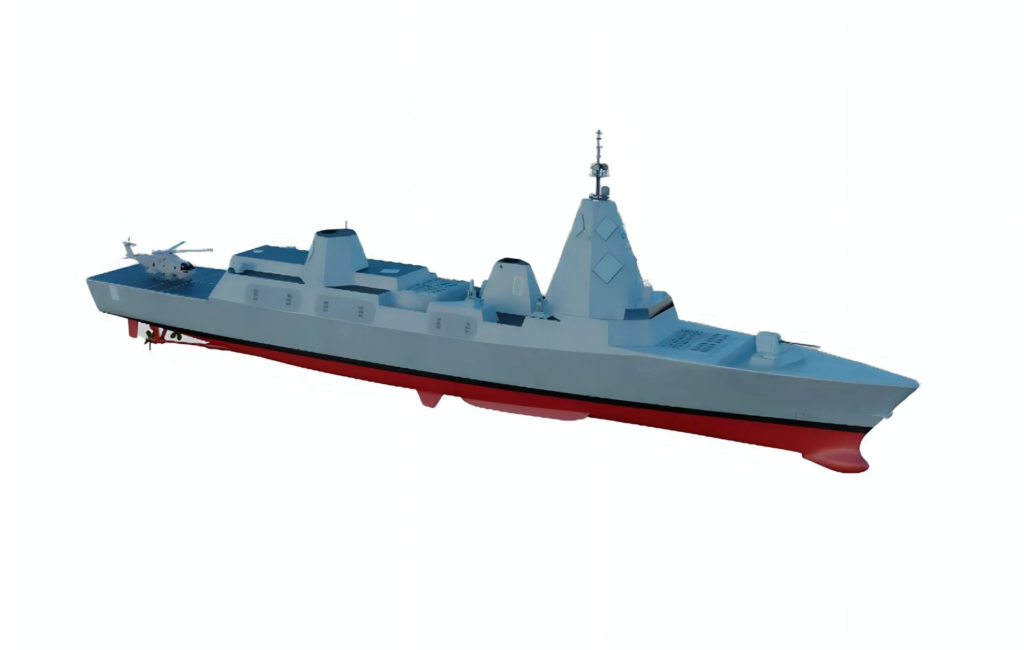
British Ministry of Defense (MoD) has given a sneak peek into its planned Type 83 destroyers, with futuristic capabilities that virtually qualify them as the naval counterparts of sixth-generation aircraft.
Defense procurement minister James Cartlidge revealed plans for the Royal Navy’s Future Air Dominance System, with the Type 83 becoming a part of the gamut.
Its defining features have been announced to be Directed Energy Weapons (DEW) and anti-hypersonic technologies. The Type 83 is expected to come into service by the mid-2030s and is slated to replace the Type 45 warships in the Royal Navy.
A report in the UK Defense Journal (UKDJ) said that a concept image had also emerged at a naval conference. Before that, Type 83 was officially unveiled in March 2021 through the publication of the United Kingdom government’s defense command paper titled, ‘Defense in a Competitive Age.’
Advertisement
Highly Advanced Air Defense Ship
The UKDJ compared it to China’s Type 055 destroyer, considered the most heavily armed and advanced in its class. It said the warship is armed with a five-inch main gun, Phalanx Close-In Weapon Systems (CIWS), two 30mm or 40mm guns, and an additional unidentified close-in weapons system (CIWS).
The ship has a sleek design with a distinctive hull that prioritizes stealth and speed and vaguely resembles the Type 26 Frigate and Type 45 destroyer. Its streamlined superstructure suggests advanced radar, sensor fusion, and data processing aided by next-generation computing technology and sophisticated algorithms.

The missile payload seems to be divided into two sets of Mk 41 vertical launch system cells, each holding an estimated 64 VLS, resulting in potentially 128 missile cells per ship.
Advertisement
Ship Will Command Drones
Cartlidge shed more light on the vessel. “Shifting to the sea domain, our Royal Navy is building its Future Air Dominance System.
Likely to comprise the new Type 83 Class platforms – which will one day replace Type 45 – these are more than just ships. They are a distributed sensor network. Effectively a ‘system of systems,’” Cartlidge said at the London Full Spectrum Air Defense Conference.
Cartlidge refers to the evolving man-unmanned teaming concept where crewed aerial platforms like fifth or sixth-generation fighters (the ‘system) control uncrewed drones or unmanned aerial vehicles (‘systems’).
The latter semi-autonomously performs many routines and complementing tasks to take the load of the manned jets.
The idea now envisages both naval and ground weapons like armored vehicles and warships. Russia, China, and the US are leading in developing unmanned surface, underwater, aerial, and ground systems for the purpose. The drones are being tested individually and with existing fifth-generation platforms like the Su-57 and the J-20.
On the naval front, for instance, the US has a large number of under-development surface and underwater maritime drones like the T-38 Devil Ray, L3Harris MAST-13, Sea Gull, Ocean Eagle 43 Medium Unmanned Surface Vessel (MUSV), and the ORCA Extra-Large Unmanned Underwater Vehicle (XLUUV).
It is also testing unmanned ships like the Mariner as a part of the Ghost Fleet Overlord program for mid-sea logistics for rearming and supplies.

Anti-A2/AD & Hypersonic
He went on to describe the ships as “highly automated” that “blend missiles with new technologies such as Directed Energy Weapons (DEWs), incorporating both uncrewed systems and complex radar sensing capabilities to raise an umbrella over our fleet, and control the air over a wider area to maintain freedom of maneuver through increased detection ranges.”
The description essentially appears to counter anti-access/area-denial (A2/AD) weapons pioneered by China. The doctrine aims to keep adversary navies at bay with long-range anti-ship cruise and ballistic missiles like the DF-21D without allowing them to get close to the mainland’s coast.
A large protective arc with newer sensors and DEWs means British military planners envisage the DEWs for destroying the ‘carrier-killer’ DF-21D or hypersonic missiles.

“As the name suggests, dominance is the name of the game. And dominance will be achieved through faster response times and greater lethality over longer distances,” Cartlidge added.
He also mentioned continuing investing in the Sea Viper Evolution program to “ensure (advanced) air and missile defense systems to protect Maritime Task Groups against increasingly more complex threats, including ballistic missiles.”
The Standard Missile (SM-3) and SM-6 carried on the US Arleigh Burke-class are also meant to shoot down nuclear-tipped ballistic missiles aimed at the US mainland, and it can be concluded the new Type 83 is being considered for a similar role.
The possibility of Royal Navy warships patrolling alongside American and Japanese vessels in the Korean Peninsula cannot be ruled out.
A previous report from June on Type 83, which also covered a presentation on the ship’s concept, mentioned the British planners considering the Australian-made CEAFAR radar for the warship – part of a later UK and Australia defense technology collaboration.
But the report clarified that the idea was only being explored and far from being finalized, as Type 83 was still in a “pre-conceptual stage.”
Developed by Australian company CEA Technologies for their eight-ship ANZAC-class frigates, the CEAFAR is an active phased array radar with a microwave tile-based design. The microwave tile and the Digital Beam Forming backend combination provide a modular, programmable, and scalable solution.